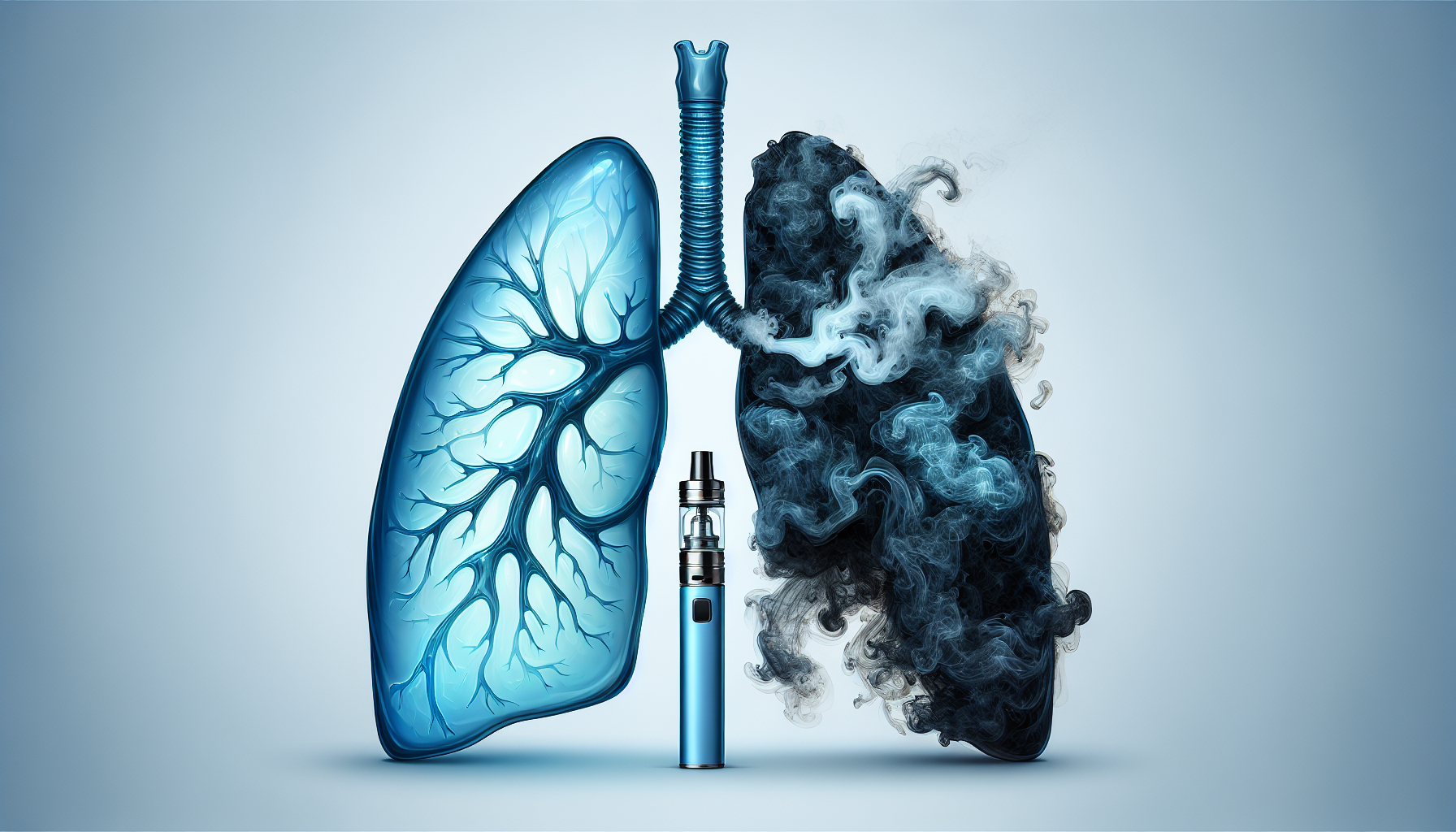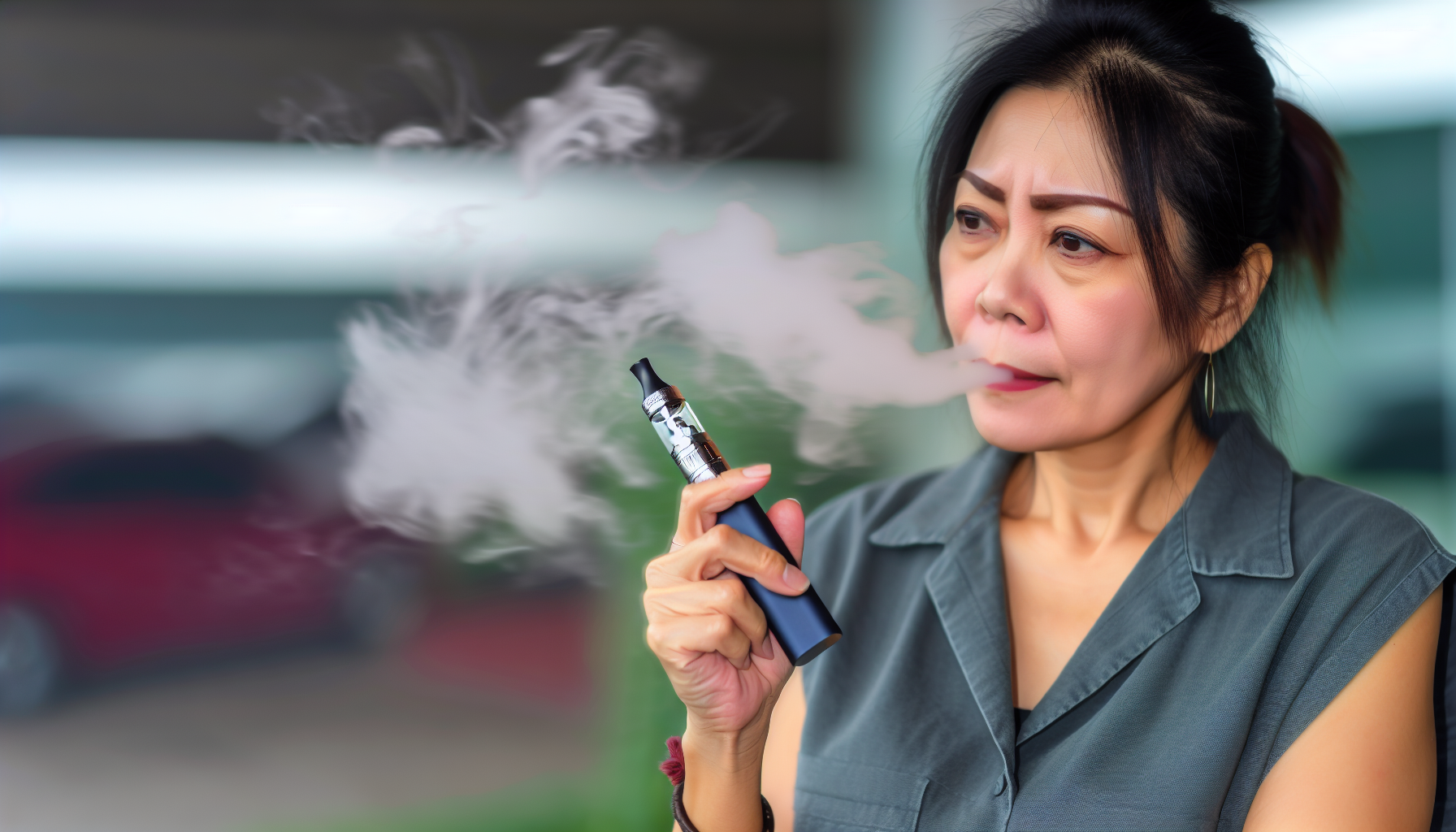Is Vaping Better Than Smoking? Examining the Pros and Cons for Healthier Choices
Puff VapesShare
Is Vaping Better Than Smoking? Examining the Pros and Cons for Healthier Choices
Wondering if “vaping better than smoking” is a valid statement? This article cuts through the noise to compare the impacts of vaping versus smoking on health. While vaping may involve fewer toxins, it’s not a risk-free alternative. We’ll examine whether vaping can be a healthier choice, its addictive nature, and if it’s an effective smoking cessation method—without endorsing products or spoiling the in-depth analysis that follows.
Key Takeaways
-
Vaping introduces fewer toxins than traditional smoking but is not risk-free, carrying potential health implications like chronic lung disease, EVALI, ‘popcorn lung’, and cardiovascular concerns due to the omnipresent nicotine.
-
Vaping devices vary in their safety profile. Risks increase with modified devices and black market liquids, underscoring the importance of regulation and responsible use.
-
Dual use of e-cigarettes and traditional cigarettes complicates smoking cessation efforts, and the transition to exclusive vaping or complete cessation is crucial for realizing the health benefits.
Understanding the Health Implications

It is essential to understand the health consequences of vaping. While it does expose users to fewer toxins compared to smoking, there are still risks involved. Vaping has been linked to chronic lung disease, asthma, and potential cardiovascular problems. Although less harmful than smoking tobacco products, it should not be considered entirely safe.
A thorough examination of the health risks associated with vaping includes a comparison between the toxins found in vape and traditional cigarettes, their impact on lung function, and concerns related to nicotine use on heart health.
Comparing Toxins in Vape vs. Tobacco Smoke
Electronic cigarettes have been found to contain significantly fewer toxic chemicals compared to regular, traditional cigarettes. They still expose users to a variety of potentially harmful substances, including volatile organic compounds like nicotine and acrolein. In fact, research has shown that electronic cigarettes vapors can also contain heavy metals such as lead and cadmium.
While it is true that e-cigarettes may pose less harm than smoking cigarettes, it’s important for individuals using them to be aware of potential risks associated with these products. Studies have identified several carcinogenic substances in vape liquids, including benzene and formaldehyde. Even flavorings used in e-cigarettes have been linked to respiratory irritation.
Despite the fact that tobacco smoke from regular cigarettes contains over 7,000 chemicals while e-cigarette vapor typically only includes around 70, there are still dangers associated with vaping products due to their exposure to various hazardous components like diacetyl and nickel.Therefore, it is crucial for consumers not to dismiss the possible health implications related to their use.Those who choosee-cigarettes instead of smoking should remain vigilant about monitoring any negative effects on their overall well-being. Always keep informed regarding new studies surrounding this topic in order to stay educated about the safety levels of different types and brands1 electronic cigarettes available on the market.
Impact on Lung Health
Vaping’s potential impact on the health of lungs is a major concern. An outbreak called EVALI, has been connected to vaping and may cause serious lung disease and injuries. Symptoms associated with this condition include chest pain and shortness of breath, with vitamin E acetate found in THC-containing cigarettes being strongly linked to it.
There is a risk for developing “popcorn lung”, which refers to an inflammation in the lungs caused by certain chemical components present in various e-cigarette flavors. Despite the fact that aerosols produced by electronic cigarettes differ from those generated by traditional smoking methods, they still have harmful effects on respiratory health. The long-term consequences of vaping on our lungs are not yet fully understood.
Cardiovascular Concerns with Nicotine
Nicotine, whether from e-cigarettes or regular cigarettes, can increase the risk of cardiovascular problems. This is because it raises blood pressure and heart rate, activates platelets, and impairs endothelial function. These effects make individuals more susceptible to acute cardiovascular events such as strokes or heart attacks.
While long-term nicotine use may not speed up the development of atherosclerosis (hardening and narrowing of arteries), it can still contribute to sudden episodes in those with preexisting cardiovascular disease. The link between smoking (which introduces nicotine along with other harmful substances) and an increased risk for heart issues has been well-established.
The Truth About Vaping and Nicotine Addiction

The issue of vaping and nicotine addiction must be acknowledged. Vaping is not a harmless activity, especially for youth and young adults, as it can lead to high levels of dependence. The use of e-cigarettes with nicotine salts creates an appealing product that promotes continued usage.
Those who are dual users, consuming both cigarettes and e-cigarettes, often struggle with higher levels of nicotine dependency, which complicates efforts toward smoking cessation. Many young individuals begin using e-cigarettes without being fully aware or informed about the risks associated with addiction due to aggressive marketing tactics employed by tobacco companies in order to create a new generation dependent on nicotine.
Nicotine Content: Electronic Cigarettes vs. Regular Cigarettes
The comparison of nicotine content in e-cigarettes and regular cigarettes is a complex matter. E-liquid can contain anywhere from 0 to 87.2 mg/ml of nicotine, making it difficult to determine the exact levels present. Most e-cigarette products indicate their nicotine strength through qualitative labels like low, medium, or high. Or quantitative measures such as mg/ml or percentage per volume.
Interestingly, those who use high-powered e-cigarettes tend to opt for lower concentrations of nicotine in their liquid due to these devices’ efficient delivery systems. However, this may lead users to ingest more overall compared to traditional cigarette smokers,resulting in a higher potential for addiction.The effectiveness of electronicnicotine delivery systemsmay be attributed to this phenomenon.
Breaking the Smoking Habit
The use of e-cigarettes in quitting smoking is a multifaceted issue. Some individuals who have incorporated vaping into their routine report successfully reducing cigarette consumption, but not necessarily giving up entirely on tobacco products. Vaping can disrupt the familiar habits and rituals associated with traditional smoking, aiding people in gradually breaking away from this harmful habit.
It should be noted that certain behavioral aspects linked to vaping could reinforce nicotine addiction. The hand-to-mouth action involved with using e-cigarettes may perpetuate the dependence on nicotine rather than facilitating full cessation of smoking. In fact, some users may end up simply substituting one form of nicotine for another by switching from traditional cigarettes to vaping without completely overcoming their addiction.
Transitioning from Smoking to Vaping

Can vaping serve as an effective tool for smoking cessation? Research studies indicate that combining vaping with support from a local Stop Smoking Service has led to successful quitting for almost two-thirds of participants. This suggests that this approach could be an effective strategy for quitting smoking. However, the full health benefits from vaping are realized only when complete cessation of smoking is achieved, which greatly reduces risks to health.
The effectiveness of e-cigarettes for smoking cessation raises questions, as does the role of dual use of e-cigarettes and traditional cigarettes - whether it aids the quitting process or hinders it.
Effectiveness of Vaping for Smoking Cessation
There is conflicting evidence regarding the effectiveness of e-cigarettes for quitting smoking. While some studies have shown higher success rates in cessation with nicotine-containing e-cigarettes compared to non-nicotine versions and traditional nicotine replacement therapy, other research suggests potential decreases in quitting rates.
When combined with behavioral support, it appears that e-cigarettes containing nicotine may be more effective than those without or alternative forms of FDA-approved nicotine replacement therapies for smoking cessation. As the Food and Drug Administration (FDA) has not approved these devices specifically for this purpose, it is recommended by the Centers for Disease Control and Prevention (CDC) to consider other options approved by the FDA due to risks such as seen during the EVALI outbreak.
Dual Use: A Stepping Stone or a Stumbling Block?
The use of both traditional cigarettes and e-cigarettes by individuals is a complicated issue. Many people engage in dual use or switch back to exclusive tobacco smoking only, while fewer are able to transition completely into using only e-cigarettes or quitting altogether.
In the years between 2015 and 2018, there has been a consistent prevalence of dual use among smokers, with approximately one out of every four also incorporating e-cigarette usage. It appears that there may be a decline in cigarette smoking among current users of e-cigarettes, which could suggest potential progress toward transitioning solely to vaping or stopping altogether. It should be noted though that engaging in dual use does not fully eliminate the health risks associated daily e cigarette use or with traditional cigarette smoking as it exposes an individual to harm from both vaping and smoking.
Safety Profile of Vaping Devices

The safety of vaping devices is a crucial aspect in the world of e-cigarettes. Proper usage and maintenance can significantly affect the well-being of users. The characteristics of these devices play a major role in altering nicotine levels in their aerosol, which not only impacts its safety but also potential addictive properties.
It’s important to address risks associated with modified devices and black market liquids used for vaping. Regulations and recommendations have been put into place to ensure the overall safety standards are met when it comes to using these products that contain high amounts of nicotine content comparable to traditional cigarettes.
Risks of Modified Devices and Black Market Liquids
It is crucial to recognize the potential dangers associated with modified vaping devices and black market e-liquids. Those who choose to modify their vaping products or use illicitly altered liquids, especially those containing THC, are at a greater risk of experiencing symptoms related to EVALI (e-cigarette or vaping product use-associated lung injury), such as chest pain, coughing, shortness of breath, fatigue, fever, nausea and vomiting.
One particular concern among individuals diagnosed with EVALI is vitamin E acetate - a thickening agent commonly used in THC-containing vape pens and products. This reinforces the importance of using regulated vaping supplies rather than modifying them or using unauthorized substances that can have serious consequences for one’s health.
Overall caution must be exercised when it comes to utilizing any type of electronic cigarette device and its accompanying liquid components. It is imperative not only for personal well-being but also for preventing future outbreaks like EVALI from occurring again.
Regulations and Recommendations
The Vaping Products Labelling and Packaging Regulations in Canada require that all vaping products comply with specific guidelines for child-resistant packaging, proper labelling, and a cap on nicotine concentration. Companies who manufacture or import these products must also submit sales data and ingredient information to Health Canada according to the regulations outlined in the Vaping Products Reporting Regulations.
Advertising of vaping products is regulated by the Vaping Products Promotion Regulations, which mandate health warnings to be included as well as restrictions on certain types of promotional activities. These measures are put in place to ensure the safety of consumers using vaping products and provide them with accurate information regarding their use.
Vaping in Specific Populations

Vaping raises concerns for all users, but some groups are especially at risk. While the vaping rates among youth have decreased, there is still worry about a new generation developing nicotine addiction. Currently, 10.0% of high school students and 4.6% of middle school students reported using e-cigarettes.
Besides young people, expecting mothers also face potential risks from e-cigarette use that could harm their health or their baby’s development during pregnancy.
It is important to note which specific brands of e-cigarettes are popular among youth as this may impact how they initially start using nicotine products and potentially become addicted in the long-term.
Youth Vaping and Initiation into Nicotine Use
E-cigarettes have gained immense popularity among young people, with disposable devices and fruity flavors being the most appealing. This has resulted in a new generation becoming addicted to nicotine, as more than 25% of current youth e-cigarette users admit to using them daily.
The presence of nicotine salts in e-cigarettes can enhance their appeal and sensory experience for those who are not accustomed to inhaling free-base nicotine, especially never smokers. Among youth e-cigarette users, the top choices for flavor include fruit-based options followed by sweet treats like candy or dessert flavors and minty varieties such as menthol.
Vaping During Pregnancy: Weighing the Risks
Pregnancy poses unique risks for those who choose to vape. The exposure to nicotine through vaping can have negative effects on the development of the fetus, making it important for pregnant individuals to avoid this practice. Medical experts strongly advise against using e-cigarettes during pregnancy and recommend exploring alternative methods of approved nicotine replacement.
Fortunately, there are safe options available in terms of nicotine replacement products that have been deemed suitable by healthcare professionals for use during pregnancy. Thus, expecting mothers who wish to quit smoking should consult with their healthcare provider in order to discuss these safer alternatives.
Environmental and Social Considerations
The use of e-cigarettes can have both social and environmental implications. Being around someone who is vaping can potentially expose others to dangerous chemicals, while proper disposal of e-cigarette materials is crucial for protecting the environment.
Secondhand exposure to aerosols from e-cigarettes can pose health risks not only to users but also those in close proximity. These substances have been linked to an increased risk of cancer and respiratory problems. The waste produced from using e-cigarettes has consequences on our surroundings that cannot be ignored due to its potential harm on the environment if not disposed properly.
Vaping Around Others: Courtesy and Health Effects
The prevalence of secondhand exposure to e-cigarette aerosols, also referred to as secondhand smoke, has risen among students from 1 in 4 between the years 2015 and 2017 to a staggering rate of 1 in 3 by the year 2017.
Of course.
-
This type of indirect exposure not only affects users but also innocent bystanders who are subjected to harmful substances that have been linked with an increased risk of cancer and respiratory issues such as bronchitis or difficulty breathing.
For vapers, it is important for them to consider those around them and refrain from vaping near individuals with existing respiratory conditions or objections to vaping. To protect the health and well-being of babies and young children, it is highly advised to avoid vaping altogether when they are present.
Responsible Disposal of Vaping Materials
The improper disposal of e-cigarettes poses a major threat to the environment, mainly due to the presence of plastic, nicotine salts, and heavy metals such as lead and mercury. These substances are non-biodegradable and can cause harm to various ecosystems when they end up in water bodies or soil. To address this issue, initiatives have been launched that aim at reducing the environmental impact caused by discarded e-cigarettes.
One solution is being provided by TerraCycle Canada through their national recycling program for e-cigarette waste. This initiative offers consumers a free way to recycle vaporizer-related items like disposable vapes, cartridges containing nicotine vape pods along with other materials used in these devices. The goal is not only to reduce plastic pollution but also hazardous electronic waste associated with these products.
Consumers can easily take part in this program either using prepaid shipping labels or dropping off their recyclable items at designated retail locations across Canada.Through this effort from TerraCycle Canada, residents now have an easy means available aimed towards safely disposing of Heet Sticks,Veev Devices Vaporizers Cartridges Pods Flexible Packaging saving our planet one puff away.
Summary
The debate surrounding vaping and smoking is complex. While vaping poses fewer health risks than traditional smoking, it does not come without any potential hazards. It may serve as a means to quit smoking. There is also the risk of fostering nicotine addiction in individuals such as youth or young adults.
Ultimately, choosing between vaping and smoking remains an individual decision. One must make well-informed choices based on up-to-date and accurate information. Remember that avoiding both options altogether is ultimately the safest approach.
Frequently Asked Questions
Is vaping better than smoking?
Although vaping is considered to be less harmful than smoking, it still poses health risks as it involves heating nicotine and various other chemicals to produce an aerosol. It is recommended to refrain from both smoking and vaping in order to maintain good health.
How many puffs of a vape is equal to a cigarette?
Based on the estimates, puffing on a vape around 30-50 times is approximately equal to smoking one cigarette. This means that a disposable vape that delivers 600 puffs is roughly equivalent to about two packs of cigarettes.
Can vaping help me quit smoking?
Vaping can be a successful method for quitting smoking as long as you completely stop the habit of smoking and effectively handle your addiction to nicotine. The level of success largely depends on these key factors.
Are there risks associated with vaping during pregnancy?
Using electronic cigarettes while pregnant can be harmful to the baby because of exposure to nicotine. For this reason, it is recommended that women avoid vaping altogether during pregnancy. The risks associated with consuming nicotine through e-cigarettes make it important for expectant mothers to refrain from using them during pregnancy.
Does secondhand exposure to e-cigarette aerosols pose health risks?
Being exposed to the vapours from e-cigarettes secondhand can potentially result in individuals being subjected to harmful substances that have been connected with a higher likelihood of developing cancer and respiratory problems.
https://puffvapesonline.com/
